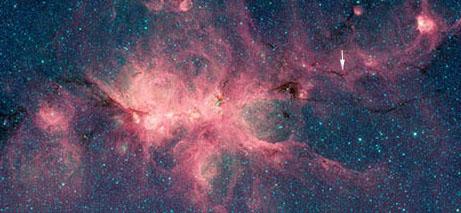
A IRAC infrared image of the massive star forming complex NGC 6334, with an arrow pointing to a cold, dark filament in which forty-nine dense, pre-stellar cores have been observed. Astronomers have found that, contrary to some expectations and earlier results, in these low-mass cores the turbulent gas velocities are not supersonic and not able to prevent gravitational collapse.
Astronomers have long realized that the process of making new stars is very inefficient. In the Milky Way the overall efficiency is only about 5% as measured by the mass in stars compared to the total mass of the galaxy. Most simple models of star formation predict that gravity should be much more effective in forming stars as it compresses the gas in molecular clouds. Various solutions have been proposed, including the disruption of molecular clouds by newly formed massive stars with powerful winds and jets, and by supersonic gas motions (generated, for example, in intercloud collisions) that can help support the cloud against collapse. Indeed, numerous observational results appear to have confirmed the presence of supersonic gas motions, at least in regions forming high-mass stars.
CfA astronomers Shanghuo Li, Qizhou Zhang, Howard Smith, and Joe Hora led a team that used the ALMA facility to study star formation in a massive, dark filamentary cloud in the complex known as NGC 6334. They observed forty-nine small, dense cores along the filament – putative sites of future low mass stars – in the emission from two molecular species that sample relatively high density, low temperature regions, H13CO+ and NH2D. The cores themselves ranged in mass from about 0.17 to 14 solar-masses. Key to the success of the project was ALMA's excellent spatial resolution, which at the distance of these clouds is 0.07 light-years, much smaller than typical in this research area, enabling the scientists to carefully measure the individual cores without contamination from adjacent material.
Images of the dark, filamentary cloud in the light of these two molecules revealed the presence of the string of dense cores, and velocity measurements revealed that the gas motions with in them were not supersonic. The authors conclude that the majority of the structures are gravitationally unstable and likely to collapse into stars. They caution that the earlier conclusions about supersonic turbulence may have been biased by using larger telescope beams that included the motions of gas not associated with individual star forming cores.
"ALMA Observations of NGC 6334S I: Forming Massive Stars and Cluster in Subsonic and Transonic Filamentary Clouds," Shanghuo Li, Qizhou Zhang, Hauyu Baobab Liu, Henrik Beuther, Aina Palau, Josep Miquel. Girart, Howard Smith, Joseph L. Hora, Yuxing Lin, Keping Qiu, Shaye Strom, Junzhi Wang, Fei Li, and Nannan Yue, ApJ (in press) 2020.